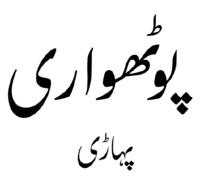Punjabi is the most widely-spoken first language in Pakistan, with 80.5 million native speakers as per the 2017 census, and the 11th most widely-spoken in India, with 31.1 million native speakers, as per the 2011 census. The language is spoken among a significant overseas diaspora, particularly in Canada, the United Kingdom, the United States, Australia, and the Gulf states. In Pakistan, Punjabi is written using the Shahmukhi alphabet, based on the Perso-Arabic script; in India, it is written using the Gurmukhi alphabet, based on the Indic scripts. Punjabi is unusual among the Indo-Aryan languages and the broader Indo-European language family in its usage of lexical tone. PASHTO Pashto (,; پښتو, Pəx̌tó, [pəʂˈto, pʊxˈto, pəʃˈto, pəçˈto]) is an Eastern Iranian language in the Indo-European language family. It is known in historical Persian literature as Afghani (افغانی, Afghāni). Spoken as a native language mostly by ethnic Pashtuns, it is one of the two official languages of Afghanistan alongside Dari, and it is the second-largest provincial language of Pakistan, spoken mainly in Khyber Pakhtunkhwa and the northern districts of Balochistan.Likewise, it is the primary language of the Pashtun diaspora around the world. The total number of Pashto-speakers is at least 40 million, although some estimates place it as high as 60 million. Pashto is "one of the primary markers of ethnic identity" amongst Pashtuns. SINDHI Sindhi (English pronunciation: ; Sindhi: سِنڌِي (Perso-Arabic); (Devanagari): सिंधी; Sindhi pronunciation: [sɪndʱiː]) is an Indo-Aryan language spoken by about 30 million people in the Pakistani province of Sindh, where it has official status. It is also spoken by a further 1.7 million people in India, where it is a scheduled language, without any state-level official status. The main writing system is the Perso-Arabic script, which accounts for the majority of the Sindhi literature and is the only one currently used in Pakistan. In India, both the Perso-Arabic script and Devanagari are used. | Sindhi |
|---|
|
|
 Sindhi written in Perso-Arabic script | | Native to | Pakistan and India |
|---|
| Region | Sindh and neighbouring regions (e.g. Kutch and Balochistan) |
|---|
| Ethnicity | Sindhis |
|---|
Native speakers | c. 32 million (2017) |
|---|
Language family | |
|---|
Writing system | Perso-Arabic (Naskh), Devanagari (India) and others |
|---|
|
Official language in |  Pakistan Pakistan Sindh Sindh
 India India |
|---|
| Regulated by | - Sindhi Language Authority (Pakistan)
- National Council for Promotion of Sindhi Language (India)
|
|---|
|
| ISO 639-1 | sd |
|---|
| ISO 639-2 | snd |
|---|
| ISO 639-3 | snd |
|---|
| Glottolog | sind1272 Sindhi |
|---|
| Linguasphere | 59-AAF-f |
|---|
The proportion of people with Sindhi as their mother tongue in each Pakistani District as of the 2017 Pakistan Census |  Sindhi is not in the category of endangered according to the classification system of the UNESCO Atlas of the World's Languages in Danger |
Sindhi has an attested history from the 10thcentury CE. Sindhi was one of the first Indo-Aryan languages to encounter influence from Persian and Arabic following the Umayyad conquest in 712 CE. A substantial body of Sindhi literature developed during the Medieval period, the most famous of which is the religious and mystic poetry of Shah Abdul Latif Bhittai from the 18th century. Modern Sindhi was promoted under British rule beginning in 1843, which led to the current status of the language in independent Pakistan after 1947. Saraiki Saraiki ( سرائیکی Sarā'īkī; also spelt Siraiki, or Seraiki) is an Indo-Aryan language of the Lahnda group, spoken by 26 million people primarily in the south-western half of the province of Punjab in Pakistan. It was previously known as Multani, after its main dialect. | Saraiki |
|---|
|
 Saraiki in Shahmukhi script (Nastaʿlīq style) | | Native to | Pakistan |
|---|
| Region | Punjab and neighbouring regions |
|---|
| Ethnicity | Saraiki |
|---|
Native speakers | 26 million (2017) |
|---|
Language family | |
|---|
Writing system | Perso-Arabic (Saraiki alphabet) |
|---|
|
| Regulated by | No official regulation |
|---|
|
| ISO 639-3 | skr |
|---|
| Glottolog | sera1259 |
|---|
The proportion of people with Saraiki as their mother tongue in each Pakistani District as of the 2017 Pakistan Census |
Saraiki has partial mutual intelligibility with Standard Punjabi, and it shares with it a large portion of its vocabulary and morphology. At the same time in its phonology it is radically different (particularly in the lack of tones, the preservation of the voiced aspirates and the development of implosive consonants), and has important grammatical features in common with the Sindhi language spoken to the south. The Saraiki language identity arose in the 1960s, encompassing more narrow local earlier identities (like Multani, Derawi or Riasati), and distinguishing itself from broader ones like that of Punjabi. BALOCHI Balochi or Baluchi (بلۏچی) is a Northwestern Iranian language spoken primarily in the Balochistan region of Pakistan, Iran and Afghanistan. In addition, there are speakers in Oman, the Arab states of the Persian Gulf, Turkmenistan, East Africa and in diaspora communities in other parts of the world. The total number of speakers, according to Ethnologue, is 8.8 million. Of these, 6.28 million are in Pakistan. | Balochi |
|---|
|
 Balòci (Balochi) written Balo-Rabi in Nastaliq style. | | Native to | Pakistan, Iran, Afghanistan |
|---|
| Region | Balochistan |
|---|
| Ethnicity | Baloch |
|---|
Native speakers | 8.8 million (2017–2020) |
|---|
Language family | |
|---|
Writing system | Balochi Standard Alphabet |
|---|
|
| Regulated by | Balochi Academy, Quetta, Balochistan, Pakistan |
|---|
|
| ISO 639-2 | bal |
|---|
| ISO 639-3 | bal – inclusive code
Individual codes:
bgp – Eastern Balochi
bgn – Western Balochi
bcc – Kachi dialect (Southern Balochi) |
|---|
| Glottolog | balo1260 |
|---|
| Linguasphere | 58-AAB-a > 58-AAB-aa (East Balochi) + 58-AAB-ab (West Balochi) + 58-AAB-ac (South Balochi) + 58-AAB-ad (Bashkardi) |
|---|
According to Brian Spooner, Literacy for most Baloch-speakers is not in Balochi, but in Urdu in Pakistan and Persian in Afghanistan and Iran. Even now very few Baloch read Balochi, in any of the countries, even though the alphabet in which it is printed is essentially identical to Persian and Urdu.
Balochi belongs to the Western Iranian subgroup, and its original homeland is suggested to be around the central Caspian region. HINDKO Hindko (ہندکو, romanized: Hindko, IPA: [ˈɦɪnd̪koː]) is a cover term for a diverse group of Lahnda dialects spoken by several million people of various ethnic backgrounds in several areas in northwestern Pakistan, primarily in the provinces of Khyber Pakhtunkhwa and northwestern regions of Punjab. | Hindko |
|---|
|
 Hindko in Shahmukhi | | Native to | Pakistan |
|---|
| Region | Hazara Division, Peshawar, Kohat, Potohar |
|---|
| Ethnicity | Hindkowans and Hazarewal |
|---|
Native speakers | 5–7 million (2017–2020) |
|---|
Language family | |
|---|
| Dialects | - Peshawari
- Kohati
- Awankari, Ghebi, Chacchi
- Hazara Hindko
|
|---|
Writing system | Shahmukhi |
|---|
|
| ISO 639-3 | Either:
hnd – Southern Hindko
hno – Northern Hindko |
|---|
| Glottolog | hind1271 |
|---|
The proportion of people with Hindko as their mother tongue in each Pakistani District as of the 2017 Pakistan Census |
There is a nascent language movement, and in recent decades Hindko-speaking intellectuals have started promoting the view of Hindko as a separate language. There is a literary tradition based on Peshawari, the urban variety of Peshawar in the northwest, and another one based on the language of Abbottabad in the northeast.In the 2017 census of Pakistan, 5.1 million people declared their language to be Hindko, while a 2020 estimate placed the number of speakers at 7 million. Hindko to some extent is mutually intelligible with Punjabi and Saraiki, and has more affinities with the latter than with the former. Differences with other Punjabi varieties are more pronounced in the morphology and phonology than in the syntax. In a sense both Hindko, as well as other Lahnda varieties, and Standard Panjabi are "dialects" of a "Greater Punjabi" macrolanguage. The word Hindko, commonly used to refer to a number of Indo-Aryan dialects spoken in the neighbourhood of Pashto, likely originally meant "the Indian language" (in contrast to Pashto). An alternative local name for this language group is Hindki. A speaker of Hindko may be referred to as Hindki, Hindkun, or Hindkowan (Hindkuwan). Like other Lahnda varieties, Hindko is derived from the Shauraseni Prakrit. Pahari-PothwariThe Indo-Aryan language spoken on the Pothohar Plateau in the far north of Pakistani Punjab, as well as in most of Pakistan's Azad Kashmir and in western areas of India's Jammu and Kashmir, is known by a variety of names, the most common of which are Pahari (; an ambiguous name also applied to unrelated languages of India and Pothwari (or Pothohari). | Pahari-Pothwari |
|---|
|
 | | Native to | Pakistan, India |
|---|
| Region | Pothohar region, Azad Kashmir and western parts of Jammu and Kashmir, other parts of India including Punjab and Haryana (by partition refugees and descendants) |
|---|
Native speakers | several million |
|---|
Language family | |
|---|
Writing system | Shahmukhi |
|---|
|
| ISO 639-3 | phr |
|---|
| Glottolog | paha1251 Pahari Potwari |
|---|
The language is transitional between Hindko and Standard Punjabi and is mutually intelligible with both. There have been efforts at cultivation as a literary language, although a local standard has not been established yet. The Shahmukhi script is used to write the language, such as in the works of Punjabi poet Mian Muhammad Bakhsh. Grierson in his early 20th-century Linguistic Survey of India assigned it to a so-called "Northern cluster" of Lahnda (Western Punjabi), but this classification, as well as the validity of the Lahnda grouping in this case, have been called into question. In a sense both Pothwari, as well as other Lahnda varieties, and Standard Panjabi are "dialects" of a "Greater Punjabi" macrolanguage. Brahui languageBrahui (; Brahui: براہوئی; also known as Brahvi or Brohi) is a Dravidian language spoken by some of the Brahui people. The language is spoken primarily in the central part of the Balochistan Province of Pakistan, with smaller communities of speakers scattered in parts of Iranian Baluchestan, Afghanistan and Turkmenistan (around Merv) and by expatriate Brahui communities in Iraq, Qatar and United Arab Emirates.It is isolated from the nearest Dravidian-speaking neighbour population of South India by a distance of more than 1,500 kilometres (930 mi). The Kalat, Khuzdar, Mastung, Quetta, Bolan, Nasirabad, Nushki, and Kharan districts of Balochistan Province are predominantly Brahui-speaking. | Brahui |
|---|
|
 The word Brahui written in the Nastaliq script | | Pronunciation | [bɾaːhuiː] |
|---|
| Native to | Pakistan, Iran, Afghanistan and Turkmenistan |
|---|
| Region | Balochistan |
|---|
| Ethnicity | Brahui and Baloch |
|---|
Native speakers | 2,640,000 in Pakistan (Total users in all countries 2,864,400) (2017 Census) |
|---|
Language family | |
|---|
Writing system | Perso-Arabic Script (Nastaʿlīq),
Latin script |
|---|
|
| ISO 639-3 | brh |
|---|
| Glottolog | brah1256 |
|---|
|
|
|










Comments
Post a Comment